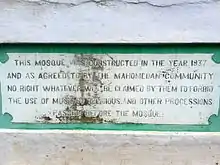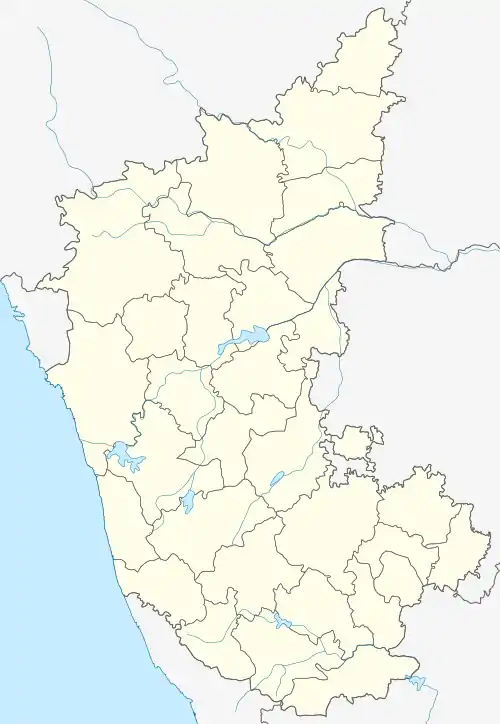Maddur, Mandya
Maddur (also pronounced as Maddūru) is a town in Mandya district in the Indian state of Karnataka. It lies on the banks of the river Shimsha. It is 82 kilometers from the state capital Bangalore and 60 kilometers from Mysore. Derived from Maddu (in Kannada) a term referring to chemicals used for explosives. According to a Tamil inscription found in Ugra Narasimha temple, the town was called Marudhur (Marudhu + Oor) during the Hoysala period, from which the name Maddur might have been derived.




Maddur
Madduru | |
|---|---|
Town | |
 Vegetable shop in Maddur | |
 Maddur Location in Karnataka, India  Maddur Maddur (India) | |
| Coordinates: 12.5849°N 77.05°E | |
| Country | |
| State | |
| District | Mandya |
| Government | |
| • Type | Town Municipal Council |
| • Body | Maddur Town Municipal Council |
| Area | |
| • Total | 6.23 km2 (2.41 sq mi) |
| Elevation | 662 m (2,172 ft) |
| Population (2011) | |
| • Total | Total: 26,456. ♂ 14,342 | /♀ 14,412 |
| • Density | 4,246.55/km2 (10,998.5/sq mi) |
| Demonym(s) | Maddurean |
| Languages | |
| • Official | Kannada |
| Time zone | UTC+5:30 (IST) |
| PIN | 571428 |
| Telephone code | 08232 |
| Vehicle registration | KA-11 |
| Website | http://maddurtown.gov.in/ |
Geography
Maddur is located at 12.584169°N 77.0449°E.[1] It has an average elevation of 662 metres (2175 ft).
Demographics
As of 2011 India census,[2] Maddur had a population of 28,754 of which 14,342 males and 14,412 females. Maddur has an average literacy rate of 68%, higher than the national average of 59.5%: male literacy is 73%, and female literacy is 63%. In Maddur, 12% of the population is under 6 years of age.
Crops
Maddur has been recently famous for its tender coconut cultivation. Nearly 300 trucks of nuts are daily sent to the other states of India such as Punjab, Maharashtra, West Bengal, Goa, Telangana, Gujarat and other states. Small towns near Maddur consume more and more tender coconuts daily. Maddur has been recently named as Tender coconut capital of India.[3][4]
Temples
Hindu Temples

Among the important temples here, thankfully still existing, is the Narasirnha temple[5] of the Hoysala period whose 7 ft high image of Ugra Narasimha made of black stone is believed to be the best of its kind in the State.
- Varadarajawamy temple
Maddur's marvelous Varadaraja temple is an early Chola or pre-Chola structure. Its 12 ft high Alialanatha deity is elaborately carved both in front and on the back with unusual features which has led to the Kannada saying 'Ella Devara Munde Nodu Allalanathana hinde nodu' - 'All other idols are to be seen from the front but Allalanatha is to be seen from the back'. The temple was built by king Vishnuvardhana (formerly known as Bitti Deva).
- Vaidyanathapura – Vidyanatheswara Temple
- Shivapura - Shivapur in Maddur is famous for the historical monument Satyagraha Soudha the symbolic structure of Maddur where Mahatma Gandhi had sat for Satyagraha against the British along with other freedom fighters. An inspiring monument of India’s freedom struggle located adjacent to the Mysuru-Bengaluru highway at Shivapura of Maddur taluk in Mandya District Built to commemorate the Shivapura Flag Satyagraha of 1938.
- Kokkarebellur – Kokkare Bellur, is a famous bird sanctuary located in maddur taluk. Its 12 km from Maddur town.
Maddur, incidentally, is also famous for the Maddur Vade – a delicious fried snack made of a variety of pulses.
Jain temple
A Jain temple dated 8th Century AD was discovered in Arathipura, Maddur by Archaeological Survey of India. The structure is built with bricks and stones and is 100 feet long and 40 feet wide. Shilabalikes (stone sculpture of young women), Dwarapalakas (gatekeepers) and a statue of Lord Bahubali (3 foot wide, 3.5 feet tall) were also discovered in the excavations.[6][7]
In 2016, Archaeological Survey of India (ASI) excavated another 13 ft (4.0 m) statue of Bahubali made in the 3rd – 9th centuries on another hillock located opposite the basadis in Arthipura. Excavation work is expected to be completed by 2018.[8]
See also
References
- Falling Rain Genomics, Inc - Maddur
- "Census of India 2011: Data from the 2011 Census, including cities, villages, and towns (Provisional)". Census Commission of India.
- Tender Coconut capital of India
- Maddur market gives Coconut growers a fair deal.
- "Sri Ugra Narasimha Temple in Maddur". Tirtha Yatra. 12 September 2015. Retrieved 16 May 2020.
- Express News Service (7 January 2015), Eighth Century Jain Temple Discovered in Maddur, The New Indian Express
- Girish, M. B. (23 February 2016) [4 December 2015], "Another Jain centre under excavation in Mandya district", Deccan Chronicle
- Girish, M. B. (23 February 2016) [4 December 2015], "Another Jain centre under excavation in Mandya district", Deccan Chronicle
External links
| Wikimedia Commons has media related to Maddur, Mandya. |